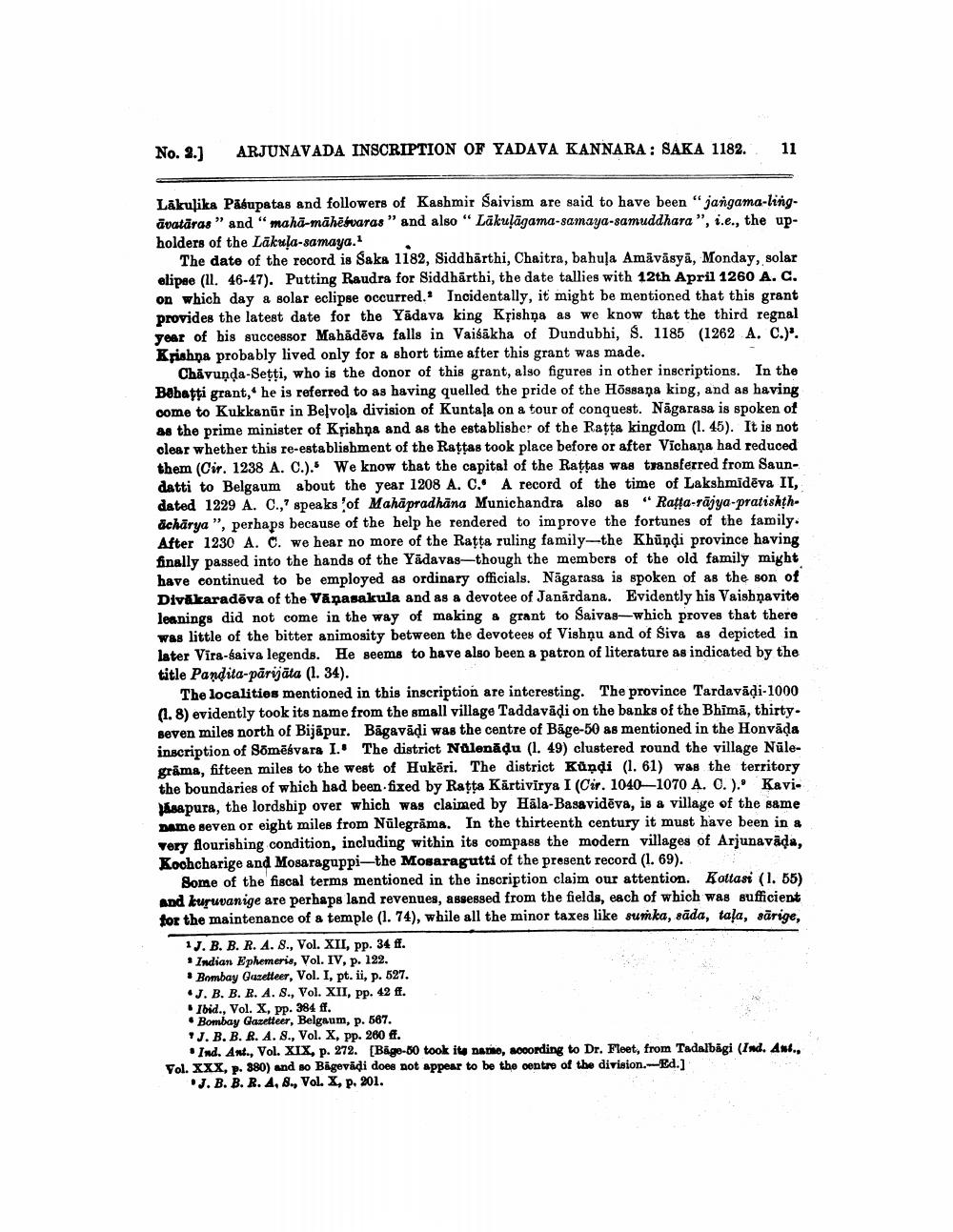________________
No. 2.)
ARJUNAVADA INSCRIPTION OF YADAVA KANNARA: SAKA 1182.
11
Läkuliks Pasupatas and followers of Kashmir Saivism are said to have been "jangama-lingävatāras " and "mahā-māhēbvaras" and also "Lākuļāgama-samaya-samuddhara ", i.e., the upholders of the Läkula-samaya.
The date of the record is Saka 1182, Siddhārthi, Chaitra, bahula Amavasya, Monday, solar elipee (I1. 46-47). Putting Raudra for Siddhārthi, the date tallies with 12th April 1260 A. C. on which day & solar eclipse occurred.' Incidentally, it might be mentioned that this grant provides the latest date for the Yadava king Kțishna as we know that the third regnal year of bis successor Mahädēva falls in Vaišākha of Dundubhi, s. 1185 (1262 A. C.)'. Krishna probably lived only for & short time after this grant was made.
Chåvunda-Setti, who is the donor of this grant, also figures in other inscriptions. In the Bebatti grant,' he is referred to as having quelled the pride of the Hossana king, and as having come to Kukkanür in Belvola division of Kuntaļa on a tour of conquest. Nägarasa is spoken of as the prime minister of Krishna and as the establisher of the Ratta kingdom (1. 45). It is not clear whether this re-establishment of the Rattas took place before or after Vichana had reduced them (Cir. 1238 A. C.). We know that the capital of the Rattas was transferred from Saundatti to Belgaum about the year 1208 A. C. A record of the time of Lakshmidēva II, dated 1229 A. C.,' speaks of Mahapradhāna Munichandra also as "Rata-rājya-pratishthacharya", perhaps because of the help he rendered to improve the fortunes of the family. After 1230 A. C. we hear no more of the Ratta ruling family-the Khữndi province having finally passed into the hands of the Yadavas-though the members of the old family might have continued to be employed as ordinary officials. Nāgarasa is spoken of as the son of Divakaradēva of the Vāpasakula and as a devotee of Janārdana. Evidently his Vaishnavite leanings did not come in the way of making a grant to Saivas-which proves that there was little of the bitter animosity between the devotees of Vishņu and of Siva as depicted in later Vira-saiva legends. He seems to have also been a patron of literature as indicated by the title Pandita-pārijāta (1. 34).
The localities mentioned in this inscription are interesting. The province Tardavādi-1000 (1.8) evidently took its name from the small village Taddavādi on the banks of the Bhimā, thirty. seven miles north of Bijapur. Bāgavādi was the centre of Bäge-50 as mentioned in the Honväda inscription of Somēbvara I.. The district Nalenādu (1. 49) clustered round the village Nulegråma, fifteen miles to the west of Hukēri. The district Kündi (1. 61) was the territory the boundaries of which had been fixed by Ratta Kärtivirya I (Cir. 1040—1070 A. 0.) Kavi. Masapura, the lordship over which was claimed by Hāla-Bas&vidēva, is a village of the same Dame seven or eight miles from Nūlegräma. In the thirteenth century it must have been in & very flourishing condition, including within its compass the modern villages of Arjunavada, Kochcharige and Mosaraguppi-the Mosaragutti of the present record (1. 69).
Some of the fiscal terms mentioned in the inscription claim our attention. Kottasi (1.55) and kuruvanige are perhaps land revenues, assessed from the fields, each of which was sufficient for the maintenance of a temple (1. 74), while all the minor taxes like sumka, sāda, taļa, särige,
1J. B. B. R. A. 8., Vol. XII, pp. 34 ff. • Indian Ephemeris, Vol. IV, p. 122. • Bombay Gazetteer, Vol. I, pt. ii, p. 527. •J. B. B. R. A. S., Vol. XII, pp. 42 ff.
Ibid., Vol. X, pp. 384 ff. • Bombay Gazetteer, Belgaum, p. 567. "J.B.B. R. A. 8., Vol. X, pp. 260 ff.
• Ind. Ant., Vol. XIX, p. 272. [Bage-50 took its DADIO, according to Dr. Fleet, from Tadalbāgi (Ind. Ani.. Vol. XXX, p. 380) and so Bagevadi does not appear to be the contre of the division.Ed.]
J. B. B. R. 4, 8., Vol. X, p. 201.




